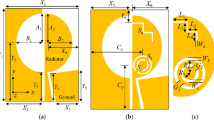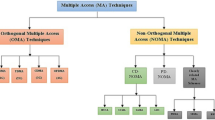Abstract
Cognitive radio (CR) has emerged as a promising technology to improve spectrum utilization. Capacity analysis is very useful in investigating the ultimate performance limits for wireless networks. Meanwhile, with increasing potential future applications for the CR systems, it is necessary to explore the limitations on their capacity in dynamic spectrum access environment. However, due to spectrum sharing in cognitive radio networks (CRNs), the capacity of the secondary network (SRN) is much more difficult to analyze than that of traditional wireless networks. To overcome this difficulty, in this paper we introduce a novel solution based on small world model to analyze the capacity of SRN. First, we propose a new method of shortcut creation for CRNs, which is based on connectivity ratio. Also, a new channel assignment algorithm is proposed, which jointly considers the available time and transmission time of the channels. And then, we derive the capacity of SRN based on small world model over multi-radio multi-channel (MRMC) environment. The simulation results show that our proposed scheme can obtain a higher capacity and smaller latency compared with traditional schemes in MRMC CRNs.









Similar content being viewed by others
References
Haykin, S. (2005). Cognitive radio: Brain-empowered wireless communications. IEEE Journal on Selected Areas in Communications, 23(2), 201–220.
Devroye, N., Mitran, P., & Tarokh, V. (2006). Limits on communications in a cognitive radio channel. IEEE Communications Magazine, 44(6), 44–49.
Srinivasa, S., & Jafar, S. A. (2007). The throughput potential of cognitive radio: A theoretical perspective. IEEE Communications Magazine, 45(5), 73–79.
Kang, X., Liang, Y.-C., Garg, H. K., et al. (2009). Sensing-based spectrum sharing in cognitive radio networks. IEEE Transactions on Vehicular Technology, 58(8), 4649–4654.
Jafarian, A., & Vishwanath, S. (2009). On the capacity of multi-user cognitive radio networks. In Proceedings of IEEE ISIT, 2009 (pp. 601–605).
Kang, X., Liang, Y.-C., Nallanathan, A., et al. (2009). Optimal power allocation for fading channels in cognitive radio networks: Ergodic capacity and outage capacity. IEEE Transactions on Wireless Communications, 8(2), 940–950.
Li, C., & Dai, H. (2011). Transport throughput of secondary networks in spectrum sharing systems. In Proceedings of IEEE INFOCOM, 2011 (pp. 2732–2740).
Zhou, P., Chang, Y., & Copeland, J. A. (2010). Capacity and delay scaling in cognitive radio ad hoc networks: Impact of primary user activity. In Proceedings of IEEE GLOBECOM, 2010 (pp. 1–6).
Fridman, A., Weber, S., Dandekar, K. R., et al. (2008). Cross-layer multicommodity capacity expansion on ad hoc wireless networks of cognitive radios. In Proceedings of CISS, 2008 (pp. 676–680).
Shi, Y., Hou, Y. T., Kompella, S., et al. (2011). Maximizing capacity in multihop cognitive radio networks under the SINR model. IEEE Transactions on Mobile Computing, 10(7), 954–967.
Watts, D. J., & Strogatz, S. H. (1998). Collective dynamics of small-world networks. Nature, 393(6638), 440–442.
Collins, J. J., & Chow, C. C. (1998). It’s a small world. Nature, 393, 409–410.
Helmy, A. (2003). Small worlds in wireless networks. IEEE Communications Letters, 7(10), 490–492.
Guidoni, D. L., Boukerche, A., Souza, F. S. H., et al. (2010). A small world model based on multi-interface and multi-channel to design heterogeneous wireless sensor networks. In Proceedings of IEEE GLOBECOM, 2010 (pp. 1–5).
Azimdoost, B., Sadjadpour, H. R., & Garcia-Luna-Aceves, J. J. (2013). Capacity of wireless networks with social behavior. IEEE Transactions on Wireless Communications, 12(1), 60–69.
How, K. C., Ma, M., & Qin, Y. (2011). Routing and QoS provisioning in cognitive radio networks. Elsevier Computer Networks, 55(1), 330–342.
Goldsmith, A., Jafar, S. A., Maric, I., & Srinivasa, S. (2009). Breaking spectrum gridlock with cognitive radios: an information theoretic perspective. In Proceedings of the IEEE, 97(5), 894–914.
Jain, R. (1991). The art of computer systems performance analysis: Techniques for experimental design, measurement, simulation, and modeling. New York: Wiley-Interscience.
Brik, V., Rozner, E., Banerjee, S., et al. (2005). DSAP: A protocol for coordinated spectrum access. In Proceedings of IEEE DySPAN 2005 (pp. 611–614).
Buddhikot, M., Kolodzy, P., Miller, S., et al. (2005). DIMSUMnet: New directions in wireless networking using coordinated dynamic spectrum. In Proceedings IEEE WoWMoM, 2005 (pp. 78–85).
Ma, Z., & Wang, H. (2012). Dynamic spectrum allocation with maximum efficiency and fairness in interactive cognitive radio networks. Wireless Personal Communications, 64(2), 439–455.
Yuan, Y., Bahl, P., Chandra, R., et al. (2007). Allocating dynamic time-spectrum blocks in cognitive radio networks. In Proceedings ACM MobiHoc, 2007 (pp. 130–139).
Zhang, L., Zeng, K., & Mohapatra, P. (2011). Opportunistic spectrum scheduling for mobile cognitive radio networks in white spaces. In Proceedings IEEE WCNC, 2011 (pp. 844–849).
Ahmadi, M., Zhuang, Y., & Pan, J. (2012). Distributed robust channel assignment for multi-radio cognitive radio networks. In Proceedings IEEE VTC (Fall), 2012 (pp. 1–5).
Zhong, X., Qin, Y., Yang, Y., & Li, L. (2014). CROR: Coding-aware opportunistic routing in multi-channel cognitive radio networks. In Proceedings IEEE GLOBECOM 2014.
Gupta, P., & Kumar, P. R. (2000). The capacity of wireless networks. IEEE Transactions on Information Theroy, 46(2), 388–404.
Akyildiz, I. F., Lee, W. Y., & Chowdhury, K. R. (2009). CRAHNs: Cognitive radio ad hoc networks. Elsevier Ad Hoc Networks, 7(5), 810–836.
Ghasemi, A., & Sousa, E. S. (2005). Collaborative spectrum sensing for opportunistic access in fading environments. In Proceedings of IEEE DySPAN, 2005 (pp. 131–136).
Kyasanur, P., & Vaidya, N. (2005). Capacity of multi-channel wireless networks: Impact of number of channels and interfaces. In Proceedings of ACM MOBICOM, 2005 (pp. 43–57).
Junior, P. R. W., Fonseca, M., Munaretto, A., et al. (2011). ZAP: A distributed channel assignment algorithm for cognitive radio networks. EURASIP Journal on Wireless Communications and Networking, 2011, 27.
Acknowledgments
Financial supports from the Shenzhen Science and Technology Fundament Research Foundation (Nos. JC200903120189A, JC201005260183A, and ZYA201106070013A) are highly appreciated. We would like to acknowledge the reviewers whose comments and suggestions significantly improved this paper.
Author information
Authors and Affiliations
Corresponding authors
Rights and permissions
About this article
Cite this article
Zhong, X., Qin, Y. & Li, L. Capacity Analysis in Multi-Radio Multi-Channel Cognitive Radio Networks: A Small World Perspective. Wireless Pers Commun 79, 2209–2225 (2014). https://doi.org/10.1007/s11277-014-1981-y
Published:
Issue Date:
DOI: https://doi.org/10.1007/s11277-014-1981-y




